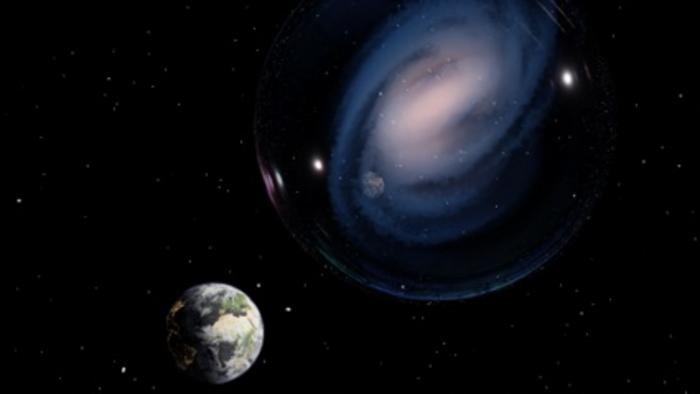Using the James Webb Space Telescope, an international team, including astronomer Alexander de la Vega of the University of California, Riverside, has discovered the most distant barred spiral galaxy similar to the Milky Way that has been observed to date.

Credit: Luca Costantin/CAB/CSIC-INTA.
Using the James Webb Space Telescope, an international team, including astronomer Alexander de la Vega of the University of California, Riverside, has discovered the most distant barred spiral galaxy similar to the Milky Way that has been observed to date.
Until now it was believed that barred spiral galaxies like the Milky Way could not be observed before the universe, estimated to be 13.8 billion years old, reached half of its current age.
The research, published in Nature this week, was led by scientists at the Centro de Astrobiología in Spain.
“This galaxy, named ceers-2112, formed soon after the Big Bang,” said coauthor de la Vega, a postdoctoral researcher in the Department of Physics and Astronomy. “Finding ceers-2112 shows that galaxies in the early universe could be as ordered as the Milky Way. This is surprising because galaxies were much more chaotic in the early universe and very few had similar structures to the Milky Way.”
Ceers-2112 has a bar in its center. De la Vega explained that a galactic bar is a structure, made of stars, within galaxies. Galactic bars resemble bars in our everyday lives, such as a candy bar. It is possible to find bars in non-spiral galaxies, he said, but they are very rare.
“Nearly all bars are found in spiral galaxies,” said de la Vega, who joined UCR last year after receiving his doctoral degree in astronomy at Johns Hopkins University. “The bar in ceers-2112 suggests that galaxies matured and became ordered much faster than we previously thought, which means some aspects of our theories of galaxy formation and evolution need revision.”
Astronomers’ previous understanding of galaxy evolution was that it took several billion years for galaxies to become ordered enough to develop bars.
“The discovery of ceers-2112 shows that it can happen in only a fraction of that time, in about one billion years or less,” de la Vega said.
According to him, galactic bars are thought to form in spiral galaxies with stars that rotate in an ordered fashion, the way they do in the Milky Way.
“In such galaxies, bars can form spontaneously due to instabilities in the spiral structure or gravitational effects from a neighboring galaxy,” de la Vega said. “In the past, when the universe was very young, galaxies were unstable and chaotic. It was thought that bars could not form or last long in galaxies in the early universe.”
The discovery of ceers-2112 is expected to change at least two aspects of astronomy.
“First, theoretical models of galaxy formation and evolution will need to account for some galaxies becoming stable enough to host bars very early in the universe’s history,” de la Vega said. “These models may need to adjust how much dark matter makes up galaxies in the early universe, as dark matter is believed to affect the rate at which bars form. Second, the discovery of ceers-2112 demonstrates that structures like bars can be detected when the universe was very young. This is important because galaxies in the distant past were smaller than they are now, which makes finding bars harder. The discovery of ceers-2112 paves the way for more bars to be discovered in the young universe.”
De la Vega helped the research team by estimating the redshift and properties of ceers-2112. He also contributed to the interpretation of the measurements.
“Redshift is an observable property of a galaxy that indicates how far away it is and how far back in time the galaxy is seen, which is a consequence of the finite speed of light,” he said.
What surprised de la Vega most about the discovery of ceers-2112 is how well the properties of its bar could be constrained.
“Initially, I thought detecting and estimating properties of bars in galaxies like ceers-2112 would be fraught with measurement uncertainties,” he said. “But the power of the James Webb Space Telescope and the expertise of our research team helped us place strong constraints on the size and shape of the bar.”
At UCR, de la Vega oversees astronomy outreach. He plans telescope nights on and off campus, and visits to local schools to give presentations on astronomy. He also leads the public astronomy talk series “Cosmic Thursdays” as well as one-off events for special occasions, such as viewing parties for eclipses.
The research paper is titled “A Milky Way-like barred spiral galaxy at a redshift of 3.”
The University of California, Riverside is a doctoral research university, a living laboratory for groundbreaking exploration of issues critical to Inland Southern California, the state and communities around the world. Reflecting California’s diverse culture, UCR’s enrollment is more than 26,000 students. The campus opened a medical school in 2013 and has reached the heart of the Coachella Valley by way of the UCR Palm Desert Center. The campus has an annual impact of more than $2.7 billion on the U.S. economy. To learn more, visit www.ucr.edu.
Journal
Nature
DOI
10.1038/s41586-023-06636-x
Method of Research
Observational study
Subject of Research
Not applicable
Article Title
A Milky Way-like barred spiral galaxy at a redshift of 3
Article Publication Date
8-Nov-2023
COI Statement
The authors declare no competing interests.




